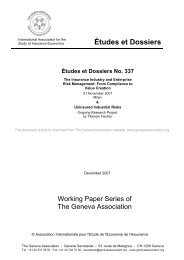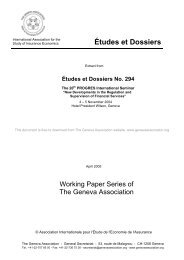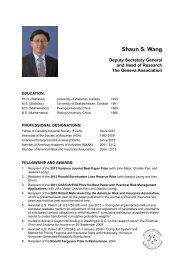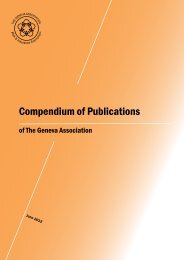Addressing the Challenge of Global Ageing—Funding Issues
Addressing the Challenge of Global Ageing—Funding Issues
Addressing the Challenge of Global Ageing—Funding Issues
Create successful ePaper yourself
Turn your PDF publications into a flip-book with our unique Google optimized e-Paper software.
30<br />
<strong>Addressing</strong> <strong>the</strong> <strong>Challenge</strong> <strong>of</strong> <strong>Global</strong> Ageing—Funding <strong>Issues</strong> and Insurance Solutions<br />
and over, <strong>the</strong>y might even consider restructuring state pension systems <strong>the</strong>mselves as<br />
“longevity backstops” that <strong>of</strong>fer greater benefits at older ages.<br />
• Increase funded retirement savings. As developed-country governments scale<br />
back pay-as-you-go benefits, it is not enough to provide additional protection to <strong>the</strong><br />
poor elderly. They will also need to ensure that <strong>the</strong> gap in <strong>the</strong> income <strong>of</strong> middleclass<br />
retirees is filled in. Meanwhile, emerging markets will have to finance adequate<br />
and affordable retirement benefits for <strong>the</strong>ir own rapidly growing middle classes.<br />
An essential part <strong>of</strong> <strong>the</strong> solution is to increase funded retirement savings. Several<br />
countries, <strong>of</strong> course, already have well-established funded retirement systems—and<br />
o<strong>the</strong>rs, from Germany and Spain to China and Korea, have recently jumpstarted new<br />
ones. While many models are possible, experience teaches that mandatory systems<br />
are more effective at ensuring broad coverage than voluntary systems. According<br />
to CSIS projections, <strong>the</strong>re are only four countries in which funded pension savings<br />
are on track to supply at least one-quarter <strong>of</strong> elderly income by 2040—Australia,<br />
Canada, <strong>the</strong> Ne<strong>the</strong>rlands and Switzerland. Of <strong>the</strong> four, only Canada has a voluntary<br />
system. Beyond improving income adequacy, funded retirement systems have<br />
o<strong>the</strong>r potentially important advantages. Depending on <strong>the</strong>ir design, <strong>the</strong>y may help<br />
to maintain adequate levels <strong>of</strong> national savings, which will be one <strong>of</strong> <strong>the</strong> greatest<br />
challenges facing ageing societies. Unlike pay-as-you-go systems, <strong>the</strong>y also allow<br />
ageing societies to escape <strong>the</strong> tyranny <strong>of</strong> <strong>the</strong>ir own demography by investing in<br />
younger and faster-growing economies around <strong>the</strong> world.<br />
• Encourage longer work lives. Perhaps no strategy for confronting <strong>the</strong> global ageing<br />
challenge <strong>of</strong>fers more potential benefits than encouraging longer work lives. Longer<br />
work lives increase <strong>the</strong> adequacy <strong>of</strong> income for <strong>the</strong> old without putting a new burden<br />
on <strong>the</strong> young. They can help ease future labour shortages and boost economic growth<br />
in fast-ageing countries with declining populations in <strong>the</strong> traditional working ages.<br />
To <strong>the</strong> extent that eligibility ages for state pension benefits are raised, <strong>the</strong>re is also a<br />
double fiscal benefit. Unlike cuts in replacement rates or indexing formulas, higher<br />
retirement ages both save on benefit costs and increase tax revenues by leng<strong>the</strong>ning<br />
<strong>the</strong> number <strong>of</strong> years in which contributions are made. Remaining productively<br />
engaged, moreover, is good not only for <strong>the</strong> health <strong>of</strong> <strong>the</strong> budget and <strong>the</strong> economy,<br />
but also, according to most gerontologists, for <strong>the</strong> health <strong>of</strong> <strong>the</strong> elderly <strong>the</strong>mselves. To<br />
leverage this strategy, countries will need to reduce government subsidies for early<br />
retirement, revise employment policies (like seniority pay scales) that make older<br />
workers costly to hire or retain, encourage lifelong learning and develop “flexible<br />
retirement” arrangements <strong>of</strong> all kinds. 10<br />
• Encourage higher birthrates. Although higher birthrates would do little to<br />
reduce <strong>the</strong> magnitude <strong>of</strong> <strong>the</strong> ageing challenge over <strong>the</strong> next two to three decades,<br />
in <strong>the</strong> longer-term nothing would do more to lower old-age dependency burdens<br />
and raise economic growth rates in today’s lowest-fertility countries. Policies that<br />
help women (and men) balance jobs and children are <strong>the</strong> lynchpin <strong>of</strong> any effective<br />
pronatal strategy. Countries that want to raise birthrates may need to reform labourmarket<br />
rules that limit part-time work options, implement parental leave policies,<br />
and provide for affordable daycare. More broadly, <strong>the</strong>y may need to move toward<br />
more flexible career patterns that allow parents to move in and out <strong>of</strong> employment to<br />
10 See Chapters 4, 8 and 9 <strong>of</strong> this report for a more detailed discussion <strong>of</strong> extending work lives.








